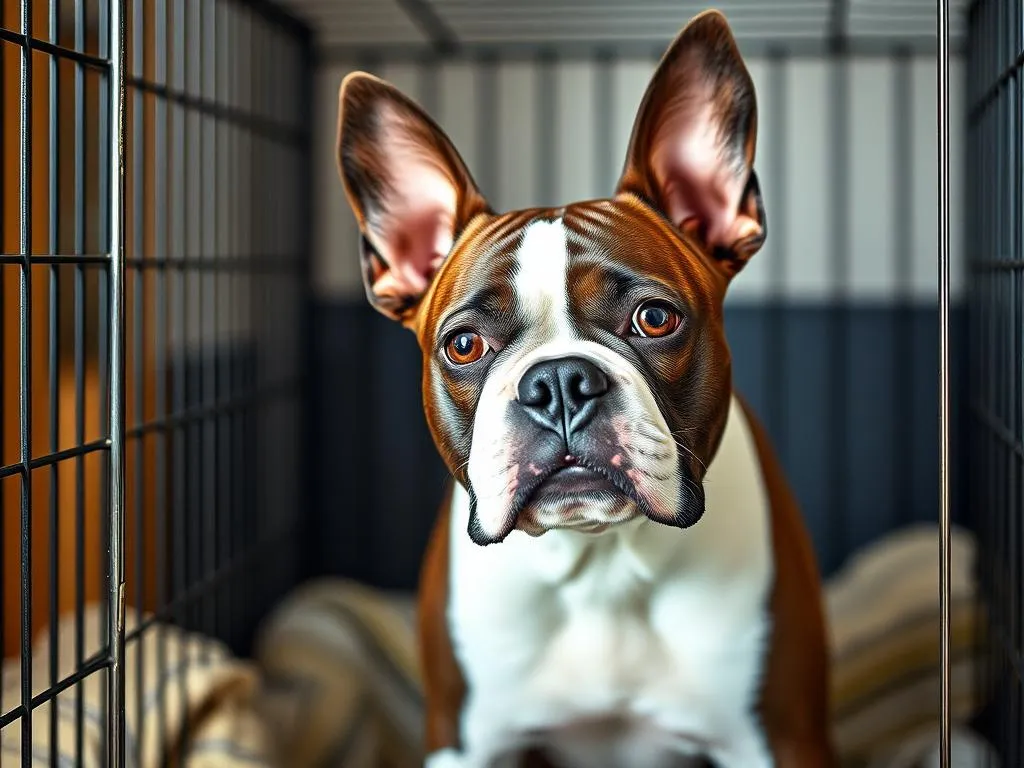
Boston Terriers are known for their charming personalities and compact physiques. These little dogs, often referred to as “American Gentlemen,” are not only adorable but also lively companions. As a breed, they are well-suited for various living situations, making them popular among city dwellers and families alike. One essential aspect of responsible dog ownership is crate training, which can significantly benefit both you and your Boston Terrier. Understanding what size crate a Boston Terrier needs is crucial to ensure comfort, safety, and security during this training process.
Understanding Boston Terriers
Characteristics of Boston Terriers
Boston Terriers typically weigh between 10 to 25 pounds and stand about 15 to 17 inches tall at the shoulder. Their petite size makes them ideal for smaller living spaces, but their playful nature requires ample room to move around and explore. Known for their affectionate and friendly demeanor, Boston Terriers often bond closely with their families. However, they may also exhibit stubbornness at times, which can make training a bit challenging.
When it comes to health, Boston Terriers can be prone to certain issues, especially those related to their brachycephalic (short-nosed) structure. This can lead to breathing difficulties, particularly in extreme temperatures or during vigorous exercise. Understanding these characteristics is essential for selecting the right crate, as it should accommodate their size while considering their health needs.
Benefits of Crate Training
Crate training offers several advantages for both the dog and the owner. First and foremost, it provides a safe space for your Boston Terrier. Dogs are den animals by nature, and having a designated area can help them feel secure. A crate can also aid in potty training, as dogs are less likely to soil their sleeping area.
Moreover, crate training can reduce anxiety by providing a familiar environment, especially during stressful situations like travel or vet visits. With a well-chosen crate, your Boston Terrier can feel at ease, knowing they have a safe retreat when needed.
Determining the Right Crate Size
Measuring Your Boston Terrier
To determine what size crate a Boston Terrier needs, it’s essential to measure your dog accurately. Start by measuring from the tip of the nose to the base of the tail for length. Next, measure from the floor to the top of their head when they are standing.
These measurements are critical because a crate that is too small can lead to discomfort and stress, while a crate that is too large may encourage your dog to use one corner as a bathroom. Ideally, your Boston Terrier should be able to stand up, turn around, and lie down comfortably in their crate.
Ideal Crate Dimensions
For adult Boston Terriers, a crate size of approximately 24 inches in length is generally recommended. This allows enough space for your dog to stretch out and move comfortably. For puppies, a smaller crate is advisable, usually around 18 to 24 inches, which allows for growth.
When selecting between different styles and materials, consider your dog’s behavior. Wire crates offer excellent ventilation and visibility, while plastic crates can provide a sense of security. Soft-sided crates are lightweight and portable, making them ideal for travel. Ultimately, the choice should align with your lifestyle and your Boston Terrier’s preferences.
Adjusting for Growth
If you’re bringing home a Boston Terrier puppy, consider investing in an adjustable crate. These crates come with dividers that enable you to resize the space as your puppy grows. This approach ensures that your dog has adequate room without feeling overwhelmed in a larger crate.
Being mindful of your puppy’s growth is crucial, as they can quickly outgrow their initial crate size. Regularly reassess your dog’s size and adjust the crate dimensions accordingly to maintain a comfortable environment.
Features to Consider When Choosing a Crate
Type of Crate
There are various types of crates available, each with its advantages and disadvantages.
-
Wire Crates: These are durable and provide excellent ventilation. They allow your dog to see their surroundings, which can help reduce anxiety. However, they might not be suitable for dogs that like to chew or escape.
-
Plastic Crates: Offering a more enclosed environment, these crates can provide a sense of security for some dogs. They are also great for travel, but can be less ventilated than wire crates.
-
Soft-Sided Crates: Lightweight and portable, these are ideal for travel. However, they may not be suitable for dogs that tend to chew or scratch.
For Boston Terriers, wire crates are often recommended due to their durability and ventilation. However, if your dog is particularly anxious, a plastic crate might offer a more comforting space.
Comfort Features
Comfort is paramount when it comes to crate selection. Ensure that the crate has proper bedding and padding to create a cozy environment. Additionally, consider the ventilation and visibility aspects. A well-ventilated crate will keep your Boston Terrier comfortable, while visibility can help them feel less isolated.
Security and Safety
Safety features in a crate are vital for ensuring your dog’s well-being. Look for strong locking mechanisms that prevent accidental escapes. Some crates also come with escape-proof features, which can be especially beneficial for a clever Boston Terrier.
Best Practices for Crate Training
Introducing the Crate to Your Boston Terrier
Introducing your Boston Terrier to their new crate should be done gradually and positively. Start by placing the crate in a common area of your home where your dog feels comfortable. Encourage them to explore the crate at their own pace by placing treats or favorite toys inside.
Positive reinforcement is key during this phase. Praise your dog when they enter the crate, and provide treats to create a positive association with their new space.
Crate Training Techniques
Once your Boston Terrier is comfortable with the crate, begin the training process. Start with short periods of time, gradually increasing the duration as your dog becomes more accustomed to being inside. Setting a routine and schedule can also help your dog feel more secure in their crate.
Be mindful of how long you leave your dog in the crate. While adult Boston Terriers can typically handle a few hours at a time, puppies may need more frequent breaks. Monitor your dog’s behavior and adjust the crate time as necessary.
Monitoring and Adjusting
Pay attention to signs of comfort and discomfort in the crate. If your Boston Terrier seems stressed or anxious, it may be necessary to reassess the crate size or type. Always prioritize their comfort and well-being above all else.
Common Mistakes to Avoid
One common mistake many pet owners make is using the crate as a form of punishment. It’s essential to establish the crate as a safe and secure space rather than a place of confinement. Avoid leaving your Boston Terrier in the crate for extended periods, as this can lead to anxiety and behavioral issues.
Additionally, choosing the wrong size crate initially can create problems. A crate that is too large may encourage bathroom habits, while one that is too small can cause discomfort. Measuring your Boston Terrier accurately and selecting the appropriate size is crucial for successful crate training.
Conclusion
In summary, choosing what size crate a Boston Terrier needs involves understanding their unique characteristics and requirements. By measuring your dog accurately and considering their comfort and safety, you can select the ideal crate. Crate training, when done correctly, can provide a secure space for your Boston Terrier, aid in potty training, and reduce anxiety.
Investing time in proper crate selection and training is essential for fostering a positive experience for your furry friend. Remember to remain patient and adjust your approach as needed to ensure your Boston Terrier thrives in their new environment. With the right crate and training techniques, you can create a safe haven where your Boston Terrier feels loved and secure.









